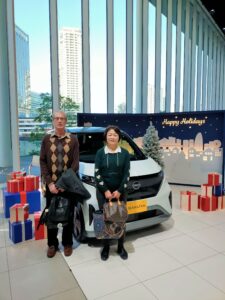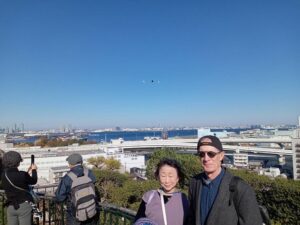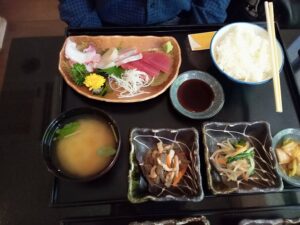Day 1
Date & Time: Wednesday, December 6, 10:30 a.m. – 5:30 p.m.
Spots: Hotel New Grand Yokohama, Yamashita Park, Yokohama Park, Bashamichi area, The Nissan Global Headquarters Gallery, Colette Mare, Motomachi area
Day 2
Date & Time: Thursday, December 7, 10:00 a.m. – 4:40 p.m.
Spots: America Yama Park, Harbor View Park, France Yama Park, British House area, The Yokohama Foreign General Cemetery, Yamate Bluff No. 234, Saint Maur International School Yokohama, Japanese restaurant at Shiokumizaka area (lunch), Motomachi area (Kikuya, homemade cookie shop), Sankeien Garden and Rose Hotel
Visitor: Steve (from Detroit, USA)
Guides: Marie, KSGG, on Day 1 and Takako, KSGG, on Day 2
Language: English
Day 1
Steve in his late 60s used to work as an engineer. He stayed in Yokohama on business for two months 40 years ago. The memories of those days are still shining in his heart. He came back to Japan to recall the days and found changes of Yokohama. It was clear after rain. The yellow-leafed trees on the roadsides were glistening with dew, and the view of the ocean lay deep blue. He admired such scenery, saying, “How beautiful!” However, foul-smell of ginkgo nuts scattered on the street upset him. He mentioned with a wry smile, “I can’t believe Japanese people eat them.” After visiting the Hotel New Grand, where Douglas MacArthur, General of the Army, and his officials stayed for three days in 1945, he walked from Yamashita Park to Yokohama Park. When he passed by Yokohama Stadium, he said in a lively voice, “I have been to Prince’s concert held here.” Steve loves music, so when walking into a Disk Union record store in Bashamichi area, he was very happy to buy three pre-owned CDs of Japanese musicians. At the Nissan Global Headquarters Gallery in Minato Mirai, he eagerly asked questions about the frame of a new car. In the commercial facility, Collette Mare, he bought a cotton shirt at UNIQLO. He enjoyed chances to communicate with a lot of people everywhere. He expressed gratitude: “I’ve got new memories.” The first day was definitely impressive for him.

Day 2
40 years ago, Steve stayed at Holiday Inn then, Rose Hotel now, in Chinatown and commuted to Yokosuka to work. A friend of his living in Los Angeles, who graduated from Saint Maur School Yokohama, asked him to take a photo of the school. So, he walked from America Yama Park to the school. Then he had sashimi (sliced raw fish) for lunch at a small Japanese restaurant near the bottom of Shiokumizaka slope. In the afternoon, he went to Sankeien Garden by bus. Sankeien Garden is a spacious Japanese garden with abundant nature. Historic structures from across Japan, including Kyoto and Kamakura, are relocated ingeniously. The garden is very famous for plum blossoms, cherry blossoms, azaleas, and autumn leaves as well as one of the prominent areas in Yokohama for experiencing various kinds of Japanese cultures. Steve listened attentively to a story about the painting called Yoroboshi*1 and gazed it intently. Being inspired by the Garyu-bai*2 planted in the garden, Kanzan Shimomura, a master artist, drew this tremendous painting. Sankei Hara, creator of Sankeien Garden, was a patron of Kanzan. Then, Steve walked around in the “Former Yanohara Family Residence*3” with great interest. On the back way to Chinatown by bus, even though Steve looked very tired from walking 17,500 steps, he kept standing to let other people sit. He happily said, “This is the first time for me to ride a bus in Japan,” With warm-hearted Steve, the guide also had a refreshing day in early winter.
*1“Yoroboshi”: Kanzan Shimomura depicted one of the scenes of “Noh,” a typical Japanese play about “Yoroboshi Syuntokumaru.” Syuntokumaru is blind and meditating on Paradise Pure Land near plum blossoms at sunset during the equinoctial season in the garden of Shitenno-ji Temple Osaka.
*2“Garyu-bai”: “Ga” means creeping, “ryu” means dragon, “bai” means plum blossom. The tree looks like dragon’s creeping.
*3“Former Yanohara Family Residence”: A wooden house with thatched roof and Irori hearth. It is designated as an Important Cultural Property. Originally located in Hida Shirakawa-go Village, Gifu Prefecture (current Shokawa-cho, Takayama City) and relocated to Sankeien Garden because of the construction of a dam. Hida Shirakawa-go Village is registered as a “The World Cultural Heritage Site” in 1995.


